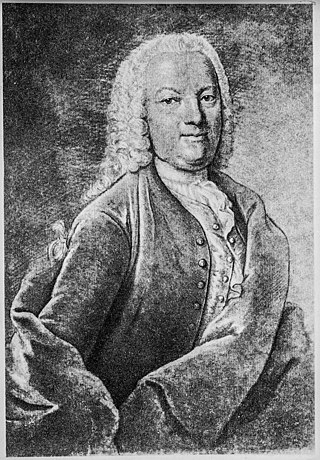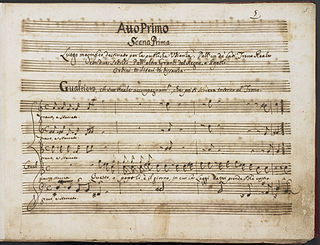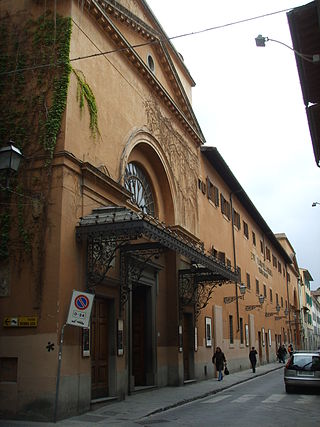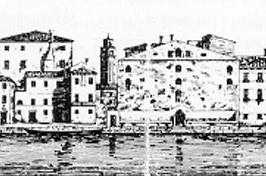
Tomaso Giovanni Albinoni was an Italian composer of the Baroque era. His output includes operas, concertos, sonatas for one to six instruments, sinfonias, and solo cantatas. While famous in his day as an opera composer, he is known today for his instrumental music, especially his concertos. He is best remembered today for a work called "Adagio in G minor", attributed to him but largely written by Remo Giazotto, a 20th century musicologist and composer, who was a cataloger of the works of Albinoni.
Remo Giazotto was an Italian musicologist, music critic, and composer, mostly known through his systematic catalogue of the works of Tomaso Albinoni. He wrote biographies of Albinoni and other composers, including Antonio Vivaldi.
The year 1726 in music involved some significant events.
The year 1722 in music involved some significant events.

Johann Georg Pisendel was a German Baroque violinist and composer who, for many years, led the Court Orchestra in Dresden as concertmaster, then the finest instrumental ensemble in Europe. He was the leading violinist of his time, and composers such as Tomaso Albinoni, Georg Philipp Telemann and Antonio Vivaldi all dedicated violin compositions to him.
The year 1700 in music involved some significant events.
Adagio in G minor for strings and organ, also known as Adagio in Sol minore per archi e organo su due spunti tematici e su un basso numerato di Tomaso Albinoni , is a neo-Baroque composition commonly attributed to the 18th-century Venetian master Tomaso Albinoni, but actually composed by 20th-century musicologist and Albinoni biographer Remo Giazotto, purportedly based on the discovery of a manuscript fragment by Albinoni. There is continuing scholarly debate about whether the alleged fragment was real or a musical hoax perpetrated by Giazotto, but there is no doubt about Giazotto's authorship of the remainder of the work.

Casanova is a 2005 American romance film directed by Lasse Hallström starring Heath Ledger and loosely based on the life of Giacomo Casanova. The film premiered September 3, 2005, at the Venice Film Festival. It received mixed reviews and flopped at the box office.
The year 1694 in music involved some significant events.
Stateira or Statira may refer to:
Domenico Natale Sarro, also Sarri was an Italian composer.
Artamene was an opera in three acts by Tomaso Albinoni set to a libretto by Bartolomeo Vitturi. Composed in 1740, it premiered in Venice at the Teatro Sant'Angelo in the 1741 carnival season. It was Albinoni's last opera. The music is lost.

Griselda is an opera seria in three acts by the Italian composer Alessandro Scarlatti, the last of Scarlatti’s operas to survive completely today. The libretto is by Apostolo Zeno, with revisions by an anonymous author. Zeno wrote his work in 1701 and it had already been set by Pollarolo and Antonio Maria Bononcini. It is based on the story of Patient Griselda from Boccaccio's tenth day of The Decameron. Scarlatti's opera was first performed at the Teatro Capranica, Rome, in January 1721 with an all-male cast.
Michael Owen Talbot, is a British musicologist and composer.

Antonio Salvi was an Italian physician, court poet and librettist, active mainly in Florence, Italy. He was in the service of the grand-ducal court of Tuscany and the favourite librettist of Prince Ferdinando de' Medici. Salvi was one of the developers of the opera seria.

The Teatro Santi Giovanni e Paolo was a theatre and opera house in Venice located on the Calle della Testa, and takes its name from the nearby Basilica of Santi Giovanni e Paolo, Venice. Built by the Grimani family in 1638, in its heyday it was considered the most beautiful and comfortable theatre in the city. The theatre played an important role in the development of opera and saw the premieres of several works by Francesco Cavalli, as well as Monteverdi's Il ritorno d'Ulisse in patria and L'incoronazione di Poppea.

Didone abbandonata was an opera in three acts composed by Tomaso Albinoni. Albinoni's music was set to Pietro Metastasio's libretto, Didone abbandonata, which was in turn based on the story of Dido and Aeneas from the fourth book of Virgil's Aeneid. The opera premiered on 26 December 1724 at the Teatro San Cassiano in Venice and was the first time that an opera based on a Metastasio libretto was performed in Venice.

The Teatro San Angelo or Teatro Sant' Angelo was once a theatre in Venice which ran from 1677 until 1803.

Zenobia, regina de’ Palmireni is an opera in three acts by Tomaso Albinoni with a libretto by Antonio Marchi. It was Albinoni’s first opera, written when he was only 23, and was first performed at the 1694 carnival at the Teatro Santi Giovanni e Paolo in Venice. The work was popular and performances continued for several weeks. Albinoni was also the first composer to write an opera on the theme of Zenobia.









